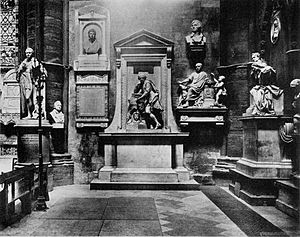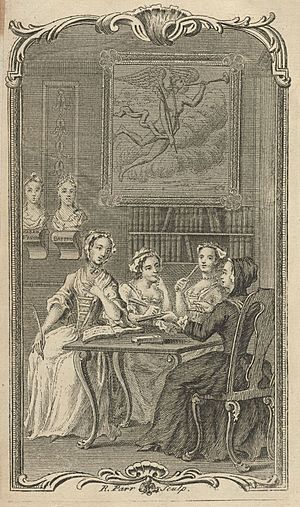Shakespeare Ladies Club facts for kids
The Shakespeare Ladies Club was a group of important women in London during the 1730s. They asked the city's theaters to perform more plays by William Shakespeare. In the 1700s, people called them "the Ladies of the Shakespear’s Club" or simply "Ladies of Quality."
Some known members were Susanna Ashley-Cooper, Elizabeth Boyd, and Mary Cowper. The club helped make Shakespeare's plays very popular again. They made sure more of his plays were shown in London during one season than ever before in the 1700s. People at the time praised them for bringing Shakespeare back into fashion.
Contents
The Shakespeare Ladies Club: History
The Shakespeare Ladies Club started in late 1736. Their main goal was to convince London's theater managers to show more of Shakespeare's plays. The Ladies wanted more Shakespeare because they found other plays of the time, like Restoration comedies, to be rude. They also didn't like the Italian operas that were very popular.
Within four years, the club succeeded! By the 1740–41 season, one out of every four plays in London was a Shakespeare play. This was a huge achievement. Even later, when famous actor David Garrick managed the Drury Lane theater, this record was not broken.
Besides getting more plays performed, the Ladies’ Club also helped create Shakespeare's statue. This statue is in Poets' Corner in Westminster Abbey. They started raising money for the statue in 1738. The statue was finally placed in Westminster Abbey in 1741.
They held at least two special shows to raise money. One was a performance of Julius Caesar on April 28, 1738. This show was at Drury Lane. The other was a performance of Hamlet on April 10, 1739. This one was at the Theatre Royal, Covent Garden, also known as the Royal Opera House.
How They Were Recognized
In January 1737, almost every Shakespeare play at Theatre Royal, Drury Lane was performed "At the Desire of several Ladies of Quality." This phrase meant the Ladies had asked for the show. It was special because it happened for almost every Shakespeare play that month.
As the Ladies gained more power at Drury Lane, people started to praise them. This praise often appeared in the opening speeches (called prologues) of new plays. It also appeared in new versions of Shakespeare's plays. For example, in a play called The Universal Passion, the prologue highly praised the Shakespeare Ladies Club.
On March 4, 1737, the New Haymarket Theater added a new prologue to a performance of Shakespeare's The Life and Death of King John. This prologue ended with a special message to the "Ladies of the Shakespear’s Club."
The special show of Julius Caesar on April 28, 1738, also had a special ending speech (an epilogue). This epilogue thanked the Ladies’ Club. It said they helped bring Shakespeare back to life, like mothers giving birth to a child.
The Shakespeare Ladies Club was also mentioned in daily newspapers. On March 3, 1737, the Grub Street Journal printed a letter. It was supposedly from the ghosts of Shakespeare and other famous writers. They praised the Ladies for encouraging good taste. The next day, the Daily Advertiser printed another letter from Shakespeare's ghost. It thanked the Ladies for forming the club and for bringing back his plays.
David Garrick's View
David Garrick was a very famous actor and theater manager. Many people think he was the one who made Shakespeare popular in the 1700s. But Garrick himself knew how important the Ladies’ Club was.
In a speech at the Shakespeare Jubilee in 1769, Garrick said, "It was You Ladies that restor’d Shakespeare to the Stage." He added that they formed a group to protect Shakespeare's fame. He also said they built a monument to him and to themselves in Westminster Abbey.
Eliza Haywood's Magazine
From 1744 to 1746, Eliza Haywood published The Female Spectator. This was a monthly magazine and the first one written by and for women. In her magazine, Haywood talked about going to the theater. She mentioned the Shakespeare Ladies’ Club's efforts. She noted their work to raise money for Shakespeare's statue. She also praised them for helping to get more of his plays performed.
Haywood wrote that these ladies showed a "truly public Spirit." She said they saved Shakespeare from being forgotten. She believed their actions deserved high praise. She felt that by preserving Shakespeare's fame, they also made their own names shine brightly for the future.
Important Members
Susanna Ashley-Cooper
Susanna Ashley-Cooper was the Countess of Shaftesbury. She was a very well-known and respected person in London society. She loved art and supported the famous composer Handel. She was the first wife of Anthony Ashley Cooper, 4th Earl of Shaftesbury. Her father was Baptiste Noel, Earl of Gainsborough.
A writer named Thomas Cooke (author) identified Susanna Ashley-Cooper as the leader of the Ladies’ Club. He did this in a poem published in 1743. The poem was called An Epistle to the Right Honourable The Countess of Shaftesbury. The famous actor David Garrick even performed the poem's opening speech at the Theatre Royal, Drury Lane.
Elizabeth Boyd
Elizabeth Boyd (1727–1745) was a writer in the early 1700s. Her play, Don Sancho: or, The students whim…with Minerva’s triumph, a masque (1739), mentions the Ladies’ Club. It talks about their plans to build Shakespeare's statue. The play is about Don Sancho calling Shakespeare's ghost in an Oxford College garden.
Even though Don Sancho was never fully performed, it was read at the Drury Lane Theatre. In her play, Boyd also showed the Ladies’ Club's goal. They wanted Shakespeare's plays to replace the rude Restoration comedies. She wrote that Shakespeare's spirit, "rouz’d by a Woman’s Pen," would stop "lawless Men."
Mary Cowper
Mary Cowper was a member of the Shakespeare Ladies’ Club. She was the daughter of William Cowper, 1st Earl Cowper. She was also an older cousin of the famous poet William Cowper. In 1743, she married William de Grey, 1st Baron Walsingham.
Mary Cowper wrote about her involvement with the club in a poem. It was titled "On the Revival of Shakespear’s Plays by the Ladies in 1738." This poem was kept in the Cowper Family Miscelany. It was later printed in full in a book called The Making of the National Poet by Michael Dobson.



